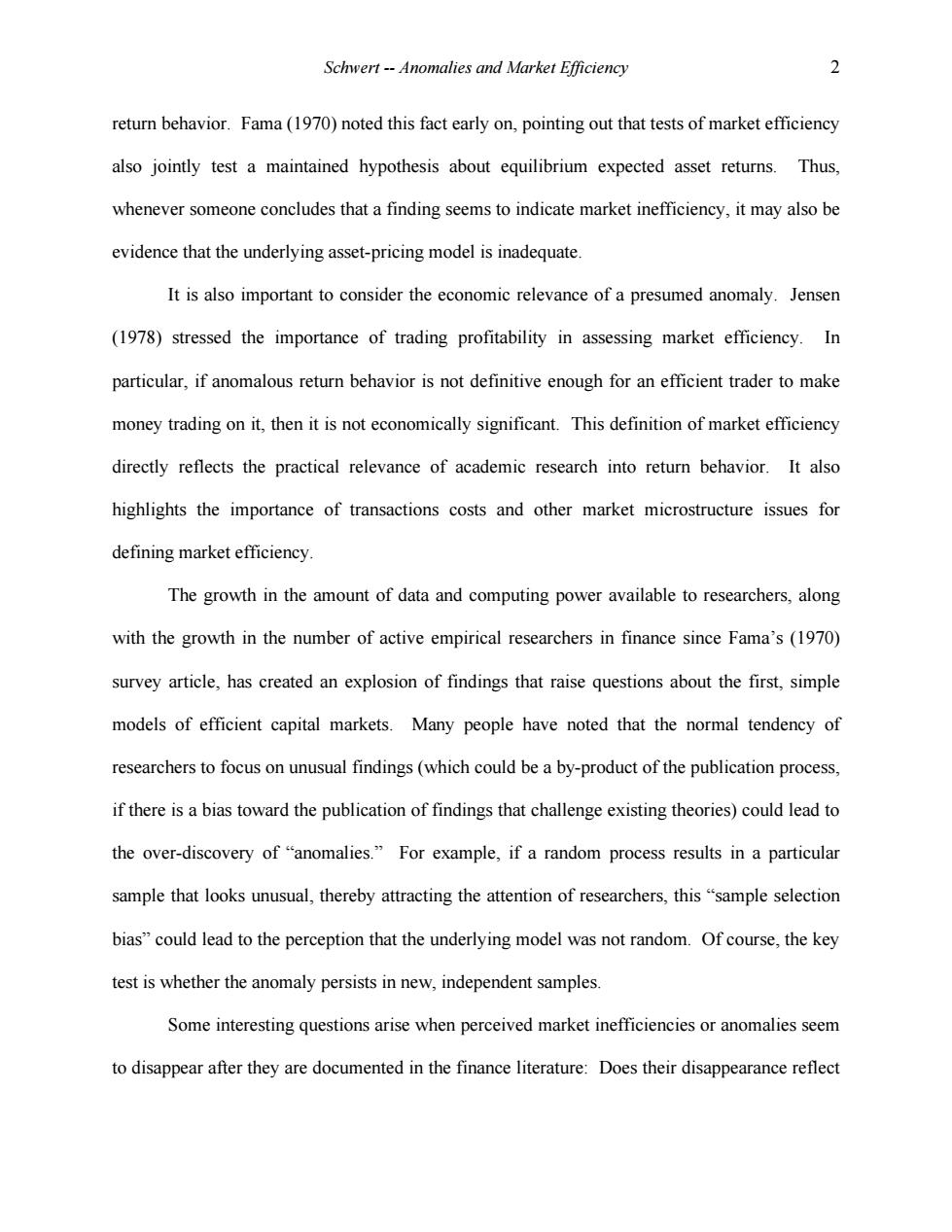正在加载图片...

Schwert--Anomalies and Market Efficiency 2 return behavior.Fama(1970)noted this fact early on,pointing out that tests of market efficiency also jointly test a maintained hypothesis about equilibrium expected asset returns.Thus, whenever someone concludes that a finding seems to indicate market inefficiency,it may also be evidence that the underlying asset-pricing model is inadequate. It is also important to consider the economic relevance of a presumed anomaly.Jensen (1978)stressed the importance of trading profitability in assessing market efficiency.In particular,if anomalous return behavior is not definitive enough for an efficient trader to make money trading on it,then it is not economically significant.This definition of market efficiency directly reflects the practical relevance of academic research into return behavior.It also highlights the importance of transactions costs and other market microstructure issues for defining market efficiency. The growth in the amount of data and computing power available to researchers,along with the growth in the number of active empirical researchers in finance since Fama's(1970) survey article,has created an explosion of findings that raise questions about the first,simple models of efficient capital markets.Many people have noted that the normal tendency of researchers to focus on unusual findings(which could be a by-product of the publication process, if there is a bias toward the publication of findings that challenge existing theories)could lead to the over-discovery of"anomalies."For example,if a random process results in a particular sample that looks unusual,thereby attracting the attention of researchers,this"sample selection bias"could lead to the perception that the underlying model was not random.Of course,the key test is whether the anomaly persists in new,independent samples Some interesting questions arise when perceived market inefficiencies or anomalies seem to disappear after they are documented in the finance literature:Does their disappearance reflectSchwert -- Anomalies and Market Efficiency 2 return behavior. Fama (1970) noted this fact early on, pointing out that tests of market efficiency also jointly test a maintained hypothesis about equilibrium expected asset returns. Thus, whenever someone concludes that a finding seems to indicate market inefficiency, it may also be evidence that the underlying asset-pricing model is inadequate. It is also important to consider the economic relevance of a presumed anomaly. Jensen (1978) stressed the importance of trading profitability in assessing market efficiency. In particular, if anomalous return behavior is not definitive enough for an efficient trader to make money trading on it, then it is not economically significant. This definition of market efficiency directly reflects the practical relevance of academic research into return behavior. It also highlights the importance of transactions costs and other market microstructure issues for defining market efficiency. The growth in the amount of data and computing power available to researchers, along with the growth in the number of active empirical researchers in finance since Fama’s (1970) survey article, has created an explosion of findings that raise questions about the first, simple models of efficient capital markets. Many people have noted that the normal tendency of researchers to focus on unusual findings (which could be a by-product of the publication process, if there is a bias toward the publication of findings that challenge existing theories) could lead to the over-discovery of “anomalies.” For example, if a random process results in a particular sample that looks unusual, thereby attracting the attention of researchers, this “sample selection bias” could lead to the perception that the underlying model was not random. Of course, the key test is whether the anomaly persists in new, independent samples. Some interesting questions arise when perceived market inefficiencies or anomalies seem to disappear after they are documented in the finance literature: Does their disappearance reflect